View in other NatureServe Network Field Guides
NatureServe
Montana
Utah
Wyoming
Idaho
Wisconsin
British Columbia
South Carolina
Yukon
California
New York
Blueweed - Echium vulgare
Other Names:
Common Viper's-bugloss
State Rank Reason (see State Rank above)
Echium vulgare is a plant native to Europe and introduced intro north-temperate North America (Lesica et al. 2012). A conservation status rank is not applicable (SNA) because the plant is an exotic (non-native) in Montana that is not a suitable target for conservation activities.
General Description
PLANTS: A taprooted biennial or short-lived perennial forb. Stems are single to many, erect, and 20–80 cm tall. Plants have two types of hairs: hispid hairs that are stout, spreading, and have a swollen red, purple, or black base, and strigose hairs that are smaller, stiff, straight, sharp, and appressed. The hispid hairs with the swollen base give the plant a spotted appearance. Sources: Graves et al. 2010; Lesica et al. 2012.
LEAVES: Leaves are basal and cauline and have the same hair types found on the stems. Basal leaves are simple with entire margins, oblanceolate in shape, petiolate, and about 6–20 cm long by 0.5-3.0 inches wide. Stem leaves are arranged alternately, linear-lanceolate in shape, and become smaller and sessile above. Sources: Graves et al. 2010; Lesica et al. 2012.
INFLORESCENCE: An elongate, bracteate raceme of helicoid cymes. Plants may have up to 50 cymes with each cyme bearing up to 20 flowers. Source: Graves et al. 2010; Lesica et al. 2012.
Phenology
Flowers June to October.
Diagnostic Characteristics
Blueweed could be confused with Phacelia species or members of the Borage Family.
Blueweed is identified by the following characteristics:
basal rosette with long, lance-shaped leaves; upper stem leaves are sessile; stems and leaves with both long and short hair types; stem appears spotted due to the swollen hairs; brightly colored blue funnel, shaped flowers growing on curled cymes; and bright pink or red stamens with 5 stamens of unequal length.
Linearleaf Phacelia - Phacelia linearis is differentiated by these characteristics:
Annual plants that lack a basal rosette; stem leaves have short-petioles (stalks); flowers are similar, but petals are lavender and more bell-shaped; the 5 stamens are exserted, but white; and the calyx is also hispid. Plants don’t have a spotted appearance.
Common Hound’s-tongue - Cynoglossom officinale is differentiated by these characteristics:
Plants have one hair type (villous) which are dense long, crooked, but unmated. Flowers (petals) are reddish-purple. Plants don’t have a spotted appearance.
Common Bugloss - Anchusa officinalisPlants have one hair type, spreading hispid hairs which lack a swollen, colored base. Flowers (petals) are purple-blue and expand from a tube (salverform), and are not funnel-shaped. The 5 stamens are short and inserted within the length of the petals. Plants don’t have a spotted appearance.
Species Range
Montana Range
Range Descriptions
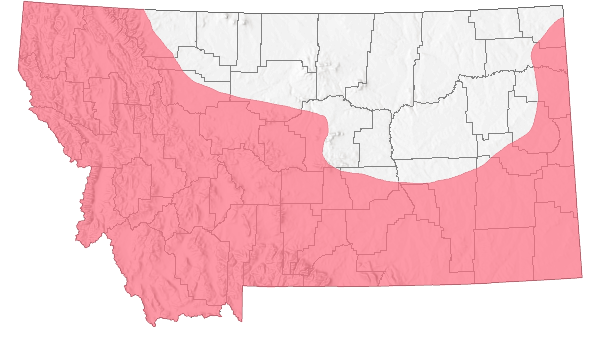
 Non-native
Non-native
Range Comments
Blueweed is native to southern Europe, and has been introduced to the U.S. in the early 1800s (Graves et al. 2010). It now is found in temperate North America (Lesica et al. 2012). Based on limited plant specimen data from the CPNWH (www.pnwherbaria.org) Blueweed was present in the mid-west during the 1860s and moved westward and northward from Montana to Washington, Oregon, and British Columbia. In Montana, Blueweed was first documented in the northwest in 1916 (www.pnwherbaria.org).
For maps and other distributional information on non-native species see:
Nonindigenous Aquatic Species Database from the U.S. Geological Survey
Invasive Species Habitat Tool (INHABIT) from the U.S. Geological Survey
Invasive Species Compendium from the Centre for Agriculture and Bioscience International (CABI)
EDDMapS Species Information EDDMapS Species Information
Observations in Montana Natural Heritage Program Database
Number of Observations: 4482
(Click on the following maps and charts to see full sized version)
Map Help and Descriptions
Relative Density
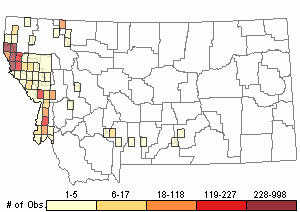
Recency
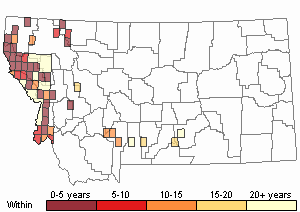
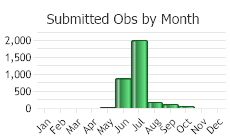

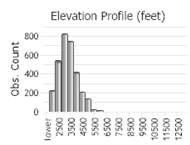 (Observations spanning multiple months or years are excluded from time charts)
(Observations spanning multiple months or years are excluded from time charts)
Habitat
Roadsides, fields, vacant lots, waterways, overgrazed pastures, and other disturbed areas (Graves et al. 2010). In Montana it grows in valleys (Lesica et al. 2012).
Ecology
Blueweed is adapted to temperate areas with cool winters and warm summers (Graves et al. 2010). It usually grows in alkaline soils with dolomite or limestone base material, but can also occur in more acidic soils. Plants do not grow well under dense vegetation, and can get outcompeted with higher soil nutrient levels.
POLLINATORS The following animal species have been reported as pollinators of this plant species or its genus where their geographic ranges overlap:
Bombus vagans,
Bombus borealis,
Bombus fervidus,
Bombus rufocinctus,
Bombus ternarius,
Bombus bimaculatus,
Bombus griseocollis, and
Bombus impatiens (Colla and Dumesh 2010).
Reproductive Characteristics
Reproduction occurs by seed and not vegetatively. Dispersal occurs primarily by humans through habitat disturbance, improper land management, contaminants in crops, and vehicle transport. Wind, water, and other animals can also transport seeds. Wind has been found to transport seeds up to 5 meters from the parent plant. Blueweed stems break allowing plants to roll and release seeds still held in the flowers. Likewise the hairy calyx can stick to animal fur and aid dispersal. It is presumed that water will transport seeds since they can float.
FLOWERS [Adapted from Graves et al. 2010; Lesica et al. 2012]
Flowers are showy. Corolla (Petals) are funnel shaped with five unequal lobes, 15-20 mm long, and typically colored blue, but can be pink, purple, or rarely white. As the flowers mature the petals become wider and the upper petal lobes longer. The calyx (sepals) are green, hispid, deeply divided, and 5-8 mm long. The 5 stamens are red or pink and unequal in length with 1 short and 4 exserted above the corolla. The style is deeply 2-lobed, hairy. The nutlets are 2–3 mm long, rugose in texture, and brown or gray with a rounded pyramid shape. The scar left by the nutlets is basal and surrounded by a rim.
Flowers are usually pollinated by bees. An average of 1,800 seeds are produced by each plant. Seeds are viable for 36 months, but it depends upon how deep they are buried. Seed viability increases with depth buried. A study found that seeds buried at 15 cm deep had a 70% germination rate.
LIFE CYCLE [Adapted from Graves et al. 2010]
Plants germinate in the spring and develop a basal rosette of leaves. The rosette overwinters with only a few leaves and a central bud. In their second year and after exposure to cold temperatures plants initiate flowering, but at different stages. Early flowering plants bloom from June to July while late flowering plants bloom from August to October.
Management
See
Noxious Weed Education VideoSuccessful management of Blueweed requires an integrated weed management strategy that promotes a weed-resistant plant community and uses surveying, monitoring, and/or grazing management strategies in combination with hand-pulling, herbicide control, and/or revegetation.
PHYSICAL and CULTURAL CONTROLS [Adapted from Graves et al. 2010]
Hand-pulling is effective for smaller infestations if the soil is moist. Pulling should be done before flowering to avoid dispersing seeds. The entire taproot should be removed in order to prevent re-sprouting. Plants should be burned (see "burning" below) or bagged and left to desiccate before disposing into the landfill. Standard practice for hand-pulling any plant includes protecting yourself by using long-sleeves and gloves. Blueweed’s stiff hairs can irritate the skin.
Mowing can reduce seed production, but will allow plants to re-sprout and produce flowers and seeds below the blade level.
Proper
vegetation management will discourage invasion. Blueweed prefers sites with low soil nutrients and sparse vegetation. Over-grazing creates gaps in the vegetation, allowing blueweed (and other weeds) to colonize. Proper management of lawns, pastures, and rangelands will promote viable populations of desirable plants. Lawns and pastures should be fertilized to increase soil fertility and competitiveness of desirable plants. Revegetation of disturbed sites may be necessary (refer to Revegetation Guidelines for Western Montana: Considering Invasive Weeds by Goodwin et al. 2006).
Burning is not an effective control because plants do not dry out well and large-scale burns can maintain a disturbed environment which favors Blueweed. Blueweed plants do not burn well, and after hand-pulling will likely require several days of air drying.
CHEMICAL CONTROL [Adapted from Graves et al. 2010]
Herbicides may be effective, especially when properly managed with other tactics. The herbicide type and concentration, timing of chemical control, soil properties, and other factors will determine its effectiveness and impact to non-target species. Strict adherence to application requirements defined on the herbicide label will reduce risks to human and environmental health. Many herbicides must be applied by applicators with an Aquatic Pest Control license. Consult your County Extension Agent and/or Weed District for more information on herbicidal control.
Studies in Ravalli County, Montana found
Metsulfuron at 1 ounce per acre or
Chlorsulfuron at 1 ounce per acre applied to rosettes in the spring or fall provided nearly 100% control one year after treatment. These studies also found that Metsulfuron (0.5 ounce per acre) mixed with Chlorsulfuron at (0.5 ounce per acre) provided nearly 100% control one year after treatment.
Pasture formulations containing
2,4-D LVE (1-2 quarts per acre) successfully controlled Blueweed when applied to the rosette state during active growth. For complete control, several applications may be necessary.
BIOLOGICAL CONTROL [Adapted from Graves et al. 2010]
There are no biological control organisms established in the U.S. for use on Blueweed. However, in the eastern U.S. three insect species are known to feed on Blueweed: a lace bug (
Dictyla echii), a moth (
Ethmia bipunctella), and a chrysomelid beetle (
Longitarsus melanurus). All have been observed to cause damage to plants. These species are not present in the western U.S., though related species of the moth and beetle are present in Montana.
Montana's Blueweed Task Force is led by Kellieann Morris who can be contacted at: (406) 777-5842 or
kmorris@rc.mt.govUseful Links:Montana Invasive Species websiteMontana Biological Weed Control Coordination ProjectMontana Department of Agriculture - Noxious WeedsMontana Weed Control AssociationMontana Weed Control Association Contacts Webpage.
Montana Fish, Wildlife, and Parks - Noxious WeedsMontana State University Integrated Pest Management ExtensionWeed Publications at Montana State University Extension - MontGuidesStewardship Responsibility
References
- Literature Cited AboveLegend:
 View Online Publication
View Online Publication Colla, S.R. and S. Dumesh. 2010. The bumble bees of southern Ontario: notes on natural history and distribution. Journal of the Entomological Society of Ontario 141:39-68.
Colla, S.R. and S. Dumesh. 2010. The bumble bees of southern Ontario: notes on natural history and distribution. Journal of the Entomological Society of Ontario 141:39-68. Goodwin, Kim, Marks Gerald, and Roger Sheley. 2006. Revegetation Guidelines for Western Montana: Considering Invasive Weeds. EB 170. Montana-Extension, Montana State University, Bozeman, Montana
Goodwin, Kim, Marks Gerald, and Roger Sheley. 2006. Revegetation Guidelines for Western Montana: Considering Invasive Weeds. EB 170. Montana-Extension, Montana State University, Bozeman, Montana Lesica, P., M.T. Lavin, and P.F. Stickney. 2012. Manual of Montana Vascular Plants. Fort Worth, TX: BRIT Press. viii + 771 p.
Lesica, P., M.T. Lavin, and P.F. Stickney. 2012. Manual of Montana Vascular Plants. Fort Worth, TX: BRIT Press. viii + 771 p.
- Additional ReferencesLegend:
 View Online Publication
View Online Publication
Do you know of a citation we're missing? Graves, Melissa, Jane Mangold, and Jim Jacobs. 2010. Biology, Ecology, and Management of Blueweed (Echium vulgare L.). March. Montana-Extension, Montana State University, Bozeman, Montana.
Graves, Melissa, Jane Mangold, and Jim Jacobs. 2010. Biology, Ecology, and Management of Blueweed (Echium vulgare L.). March. Montana-Extension, Montana State University, Bozeman, Montana. Lesica, P., M.T. Lavin, and P.F. Stickney. 2022. Manual of Montana Vascular Plants, Second Edition. Fort Worth, TX: BRIT Press. viii + 779 p.
Lesica, P., M.T. Lavin, and P.F. Stickney. 2022. Manual of Montana Vascular Plants, Second Edition. Fort Worth, TX: BRIT Press. viii + 779 p.
- Web Search Engines for Articles on "Blueweed"





